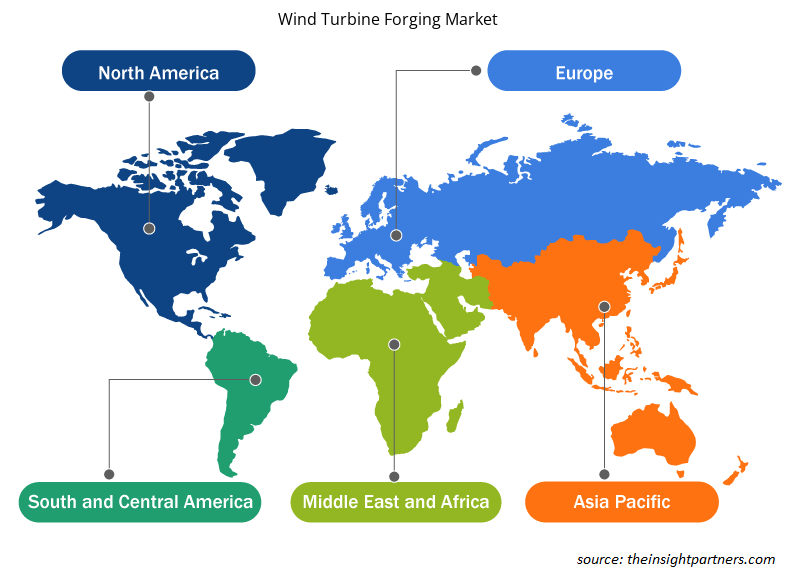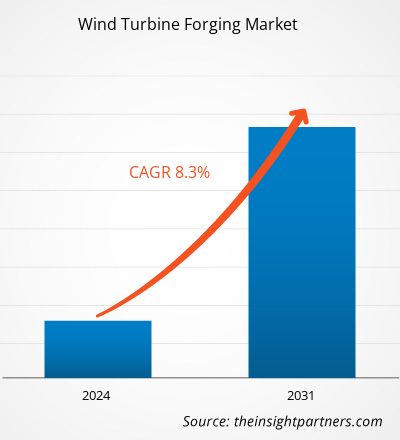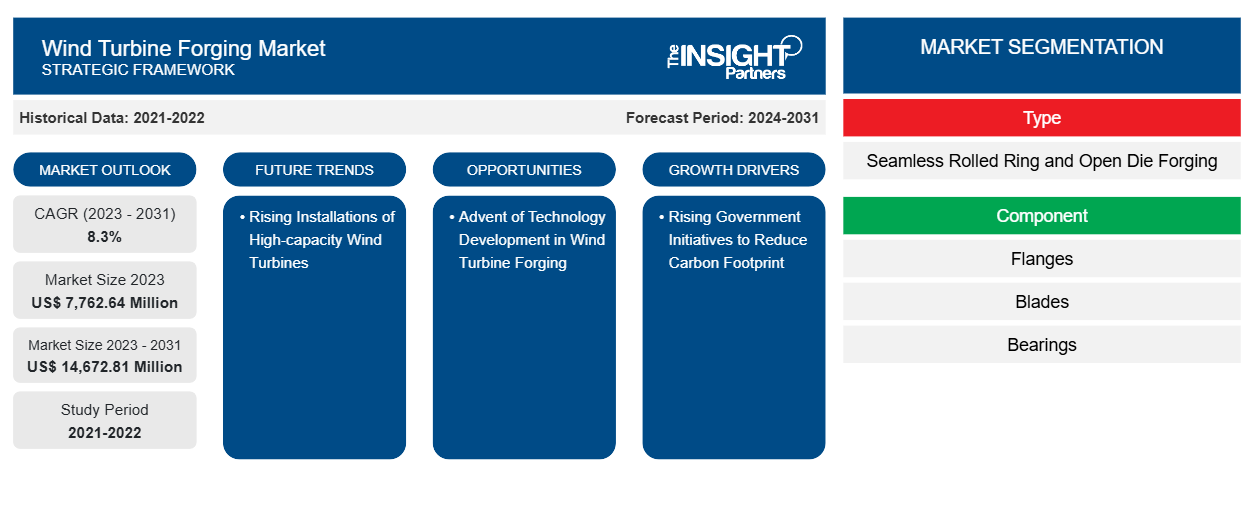풍력 터빈 단조 시장 규모는 2023년 7,762.64백만 달러에서 2031년까지 14,672.81백만 달러로 성장할 것으로 예상됩니다. 이 시장은 2023~2031년 동안 8.3%의 CAGR을 기록할 것으로 예상됩니다 . 풍력 부문의 기술 개발의 출현은 시장의 주요 추세로 남을 가능성이 높습니다.
풍력 터빈 단조 시장 분석
풍력 터빈 단조 시장 생태계는 Frisa , Iraeta , Ulma Forged Solutions, Celsa Nordic, Bharat Forge로 구성되어 있습니다. 이러한 이해 관계자에는 원자재 공급업체, 구성 요소 제조업체 및 최종 사용자가 포함됩니다. 풍력 터빈 단조는 풍력 터빈 시스템의 중요한 부분입니다. 원자재 공급업체는 단조 제품 제조업체에 풍력 터빈 샤프트용 강철 또는 풍력 터빈 타워용 콘크리트와 같은 재료를 제공합니다. 그런 다음 제조업체는 강철로 단조된 풍력 터빈의 메인 샤프트를 개발하여 단조 공정에서 경화 및 템퍼링됩니다. 관형 강철 타워는 각 끝에 플랜지가 있는 20~30m로 제조됩니다. FRISA는 풍력 터빈 플랫폼용 고성능 풍력 터빈 단조품을 제공합니다. 그런 다음 구성 요소 제조업체는 풍력 산업의 OEM 에 단조 부품을 제공합니다 . 최대 3m 직경과 단면 및 단조 블레이드를 갖춘 링 롤링 공정에 대한 수요가 증가함에 따라 풍력 터빈 단조 시장이 성장하고 있습니다.
풍력 터빈 단조 시장 개요
풍력 터빈 단조 공급업체에는 Scot Forge Company, Specialtyring , Irizar Forge, Tongyu Heavy Industry Co., Ltd, Bortome 과 같은 회사가 있으며 , 이들은 풍력 에너지 산업의 최종 사용자에게 단조 제품을 제공합니다. 이러한 회사는 재생 에너지 부문에 중요한 구성 요소를 공급하고 있으며 제품 포트폴리오와 고객 기반을 지속적으로 확장하고 있습니다. 육상 및 해상 풍력 발전소와 터빈의 건설이 증가함에 따라 향후 몇 년 동안 글로벌 풍력 터빈 단조 시장 수요가 증가할 것으로 예상됩니다.
귀하의 요구 사항에 맞게 이 보고서를 사용자 정의하세요
이 보고서의 일부 또는 국가 수준 분석, Excel 데이터 팩을 포함하여 모든 보고서에 대한 사용자 정의를 무료로 받을 수 있으며 신생 기업 및 대학을 위한 훌륭한 혜택과 할인 혜택을 이용할 수 있습니다.
-
이 보고서의 주요 시장 동향을 알아보세요.이 무료 샘플에는 시장 동향부터 추정 및 예측까지 다양한 데이터 분석이 포함됩니다.
풍력 터빈 단조 시장 동인 및 기회
시장을 선호하기 위한 탄소 발자국 감소를 위한 정부 이니셔티브 증가
격려적인 정부 명령과 이니셔티브는 전 세계적으로 탄소 발자국을 줄일 것으로 예상되는 청정 에너지 부문의 확장을 지원하고 있습니다. 2030년까지 산업, 주거 및 상업 부문의 탄소 배출을 완화하기 위한 목표를 수립하는 데 대한 정부의 집중이 커지면서 전 세계적으로 풍력 터빈 단조 시장이 성장할 것으로 예상됩니다. 러시아와 우크라이나 전쟁으로 인해 에너지 위기가 심각해졌습니다. 그러나 이탈리아, 영국, 네덜란드와 같은 국가가 풍력 발전 설치와 같은 재생 에너지에 대한 투자와 노력을 전환함에 따라 에너지 위기는 재생 에너지 부문에 긍정적입니다. 러시아의 우크라이나 침공으로 화석 연료에 대한 의존도를 줄이기 위해 전 세계적으로 재생 에너지 산업에 대한 투자가 가속화되었습니다. 이 국가들은 에너지 수요를 충족시키기 위해 녹색 에너지 목표를 업데이트했습니다 . 게다가 러시아-우크라이나 전쟁으로 인해 아시아 국가에서 재생 에너지 부문의 성장이 가속화되었습니다. 한국과 일본은 이미 수소 기술에 투자했으며 러시아-우크라이나 전쟁으로 인해 재생 에너지 산업 투자가 더욱 가속화되었습니다. 따라서 전 세계적으로 풍력 터빈 설치 수가 늘어나면서 풍력 터빈 단조 솔루션에 대한 수요도 증가했습니다.
풍력 터빈 단조 기술 개발의 출현
컴퓨터 지원 엔지니어링은 금속 요소에 충격 하중을 가하여 요소의 필요한 모양을 만드는 제조 공정인 단조에서 빠르게 구현되고 있습니다. 단조 산업에서 CAE 기술을 활용함으로써 제품 제조 중 리드 타임과 오류가 상당히 줄어들어 프로세스가 더욱 효율적이 되었으며, 이는 시장에 높은 성장 기회를 제공할 것으로 예상됩니다.
풍력 터빈 단조 시장 보고서 세분화 분석
풍력 터빈 단조 시장 분석에 기여한 주요 세그먼트는 유형과 구성 요소입니다.
- 풍력 터빈 단조 시장은 유형에 따라 무봉제 압연 링과오픈 다이 포징. 오픈 다이 포징 세그먼트는 2023년에 더 큰 시장 점유율을 차지했습니다.
- 응용 프로그램별로 시장은 플랜지, 블레이드, 베어링, 기어, 샤프트 등으로 세분화됩니다. 플랜지 세그먼트는 2023년에 시장에서 상당한 점유율을 차지했습니다.
지역별 풍력 터빈 단조 시장 점유율 분석
풍력 터빈 단조 시장 보고서의 지리적 범위는 주로 북미, 아시아 태평양, 유럽, 중동 및 아프리카, 남미 및 중부 아메리카의 5개 지역으로 나뉩니다.
아시아 태평양이 시장을 선도하고 있습니다. 아시아 태평양은 전 세계적으로 인구 밀도가 높은 지역으로 에너지 수요가 높습니다. 아시아 태평양 지역은 에너지 생산을 위해 화석 연료에 극도로 의존하고 있으며, 의존도를 줄이기 위해 중국, 인도, 일본, 호주와 같은 국가는 재생 에너지 프로젝트에 적극적으로 투자하고 있습니다. 이에 더해 러시아와 우크라이나 전쟁으로 인해 이 지역의 원유 가격이 급등하면서 이 지역의 에너지 위기가 더욱 심화되었습니다. 따라서 아시아 지역의 전반적인 에너지 위기는 풍력 및 태양광 에너지 프로젝트에 대한 투자를 크게 촉진했습니다. 사실, 중국은 가장 큰 제조업체이자 전 세계에서 가장 큰 풍력 에너지 프로젝트 설비를 보유하고 있습니다. 마찬가지로 인도와 일본도 재생 에너지 부문의 개발에 크게 기여하고 있습니다. 따라서 에너지 위기는 풍력 터빈 단조 산업에 상당한 긍정적 영향을 미치며, 풍력 터빈 설치가 증가함에 따라 단조 구성 요소에 대한 수요도 증가할 것입니다.
풍력 터빈 단조 시장 지역 통찰력
Insight Partners의 분석가들은 예측 기간 동안 풍력 터빈 단조 시장에 영향을 미치는 지역적 추세와 요인을 철저히 설명했습니다. 이 섹션에서는 북미, 유럽, 아시아 태평양, 중동 및 아프리카, 남미 및 중미의 풍력 터빈 단조 시장 세그먼트와 지리에 대해서도 설명합니다.

- 풍력 터빈 단조 시장에 대한 지역별 특정 데이터 얻기
풍력 터빈 단조 시장 보고서 범위
| 보고서 속성 | 세부 |
|---|---|
| 2023년 시장 규모 | 7,762.64백만 달러 |
| 2031년까지 시장 규모 | 14,672.81백만 달러 |
| 글로벌 CAGR (2023-2031) | 8.3% |
| 역사적 데이터 | 2021-2022 |
| 예측 기간 | 2024-2031 |
| 다루는 세그먼트 |
유형별로
|
| 포함된 지역 및 국가 |
북아메리카
|
| 시장 선도 기업 및 주요 회사 프로필 |
|
시장 참여자 밀도: 비즈니스 역학에 미치는 영향 이해
풍력 터빈 단조 시장은 소비자 선호도의 변화, 기술 발전, 제품의 이점에 대한 인식 증가와 같은 요인으로 인해 최종 사용자 수요가 증가함에 따라 빠르게 성장하고 있습니다. 수요가 증가함에 따라 기업은 제품을 확장하고, 소비자의 요구를 충족하기 위해 혁신하고, 새로운 트렌드를 활용하여 시장 성장을 더욱 촉진하고 있습니다.
시장 참여자 밀도는 특정 시장이나 산업 내에서 운영되는 회사나 기업의 분포를 말합니다. 주어진 시장 공간에 얼마나 많은 경쟁자(시장 참여자)가 존재하는지 그 규모나 전체 시장 가치에 비해 나타냅니다.
풍력 터빈 단조 시장에서 운영되는 주요 회사는 다음과 같습니다.
- 스콧 포지 주식회사
- 프리사 인더스트리아스 SA 드 CV
- 이라에타 에너지 장비 주식회사
- ULMA 포르자 S 쿠프
- 셀사 아머링스탈 AS
- 바라트 포지 유한회사
면책 조항 : 위에 나열된 회사는 어떤 특별한 순서에 따라 순위가 매겨지지 않았습니다.

- 풍력 터빈 단조 시장 주요 업체 개요 알아보기
풍력 터빈 단조 시장 뉴스 및 최근 개발
풍력 터빈 단조 시장은 1차 및 2차 연구 이후의 정성적, 정량적 데이터를 수집하여 평가합니다. 여기에는 중요한 기업 간행물, 협회 데이터 및 데이터베이스가 포함됩니다. 풍력 터빈 단조 시장의 몇 가지 개발 사항은 다음과 같습니다.
- Moray West 해상 풍력 프로젝트 플랜지는 Iraeta에서 성공적으로 운송되었습니다. 이 플랜지는 SGRE 14MW 풍력 터빈을 사용하는 스코틀랜드의 Moray West 해상 풍력 프로젝트에 사용될 것으로 알려졌습니다. Iraeta는 이 프로젝트를 위해 TP 플랜지 62세트와 MPS 30세트를 모두 수행하여 총 152개의 플랜지를 만들었습니다. (출처: Iraeta Energy Equipment Co Ltd, 보도자료, 2022년 11월)
- Bharat Forge는 Green Steel을 활용한 단조품 공급을 시작하여 탄소 발자국을 줄이려는 회사의 의지를 강화합니다. (출처: Bharat Forge, 보도자료, 2022년 12월)
풍력 터빈 단조 시장 보고서 범위 및 제공물
"풍력 터빈 단조 시장 규모 및 예측(2021-2031)" 보고서는 아래 영역을 포괄하는 시장에 대한 자세한 분석을 제공합니다.
- 범위에 포함된 모든 주요 시장 세그먼트에 대한 글로벌, 지역 및 국가 수준의 풍력 터빈 단조 시장 규모 및 예측
- 풍력 터빈 단조 시장 동향 및 드라이버, 제약 및 주요 기회와 같은 시장 역학
- 자세한 PEST 및 SWOT 분석
- 주요 시장 동향, 글로벌 및 지역 프레임워크, 주요 업체, 규정 및 최근 시장 개발 사항을 포괄하는 풍력 터빈 단조 시장 분석
- 시장 집중도, 히트맵 분석, 유명 업체, 풍력 터빈 단조 시장의 최근 개발 사항을 다루는 산업 환경 및 경쟁 분석
- 자세한 회사 프로필
- 과거 분석(2년), 기준 연도, CAGR을 포함한 예측(7년)
- PEST 및 SWOT 분석
- 시장 규모 가치/거래량 - 글로벌, 지역, 국가
- 산업 및 경쟁 환경
- Excel 데이터세트
최근 보고서
관련 보고서
사용 후기
구매 이유
- 정보에 기반한 의사 결정
- 시장 역학 이해
- 경쟁 분석
- 고객 인사이트
- 시장 예측
- 위험 완화
- 전략 기획
- 투자 타당성 분석
- 신흥 시장 파악
- 마케팅 전략 강화
- 운영 효율성 향상
- 규제 동향에 발맞춰 대응























 무료 샘플 받기 - 풍력 터빈 단조 시장
무료 샘플 받기 - 풍력 터빈 단조 시장